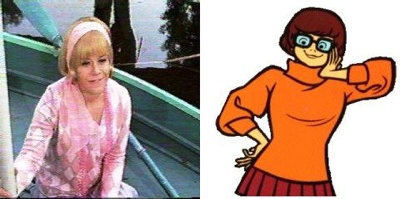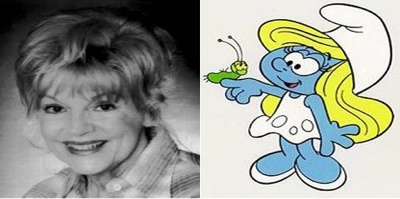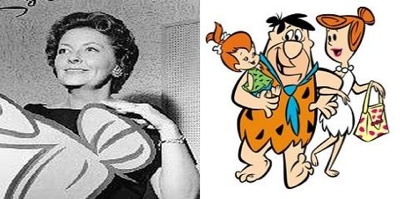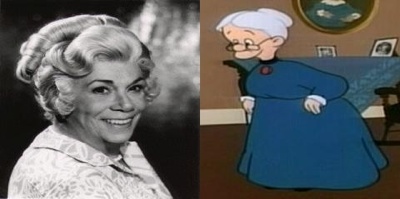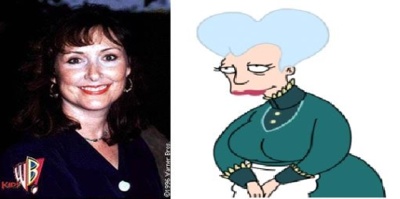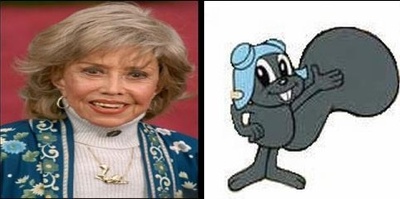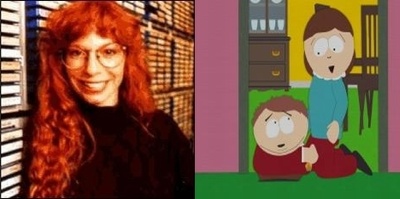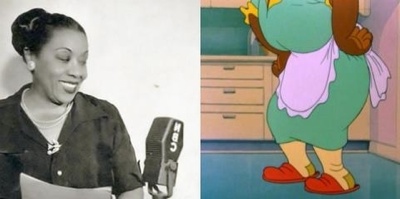 Weird Stuff
Weird Stuff  Weird Stuff
Weird Stuff  Our World
Our World 10 Ways Your Christmas Tree Is More Lit Than You Think
 Movies and TV
Movies and TV The 10 Coolest Stars to Set Sail on The Love Boat
 History
History 10 Things You Didn’t Know About the American National Anthem
 Technology
Technology Top 10 Everyday Tech Buzzwords That Hide a Darker Past
 Humans
Humans 10 Everyday Human Behaviors That Are Actually Survival Instincts
 Animals
Animals 10 Animals That Humiliated and Harmed Historical Leaders
 History
History 10 Most Influential Protests in Modern History
 Creepy
Creepy 10 More Representations of Death from Myth, Legend, and Folktale
 Technology
Technology 10 Scientific Breakthroughs of 2025 That’ll Change Everything
 Weird Stuff
Weird Stuff Ten Bizarre Facts About The Doge Meme
 Our World
Our World 10 Ways Your Christmas Tree Is More Lit Than You Think
 Movies and TV
Movies and TV The 10 Coolest Stars to Set Sail on The Love Boat
Who's Behind Listverse?

Jamie Frater
Head Editor
Jamie founded Listverse due to an insatiable desire to share fascinating, obscure, and bizarre facts. He has been a guest speaker on numerous national radio and television stations and is a five time published author.
More About Us History
History 10 Things You Didn’t Know About the American National Anthem
 Technology
Technology Top 10 Everyday Tech Buzzwords That Hide a Darker Past
 Humans
Humans 10 Everyday Human Behaviors That Are Actually Survival Instincts
 Animals
Animals 10 Animals That Humiliated and Harmed Historical Leaders
 History
History 10 Most Influential Protests in Modern History
 Creepy
Creepy 10 More Representations of Death from Myth, Legend, and Folktale
 Technology
Technology 10 Scientific Breakthroughs of 2025 That’ll Change Everything
10 Great Female Cartoon Voice Actors
To create a great cartoon, a creative team must have two ingredients: great writing, and great voice acting. Low quality animation (such as the limited animation style of the 1970’s era Hanna Barbera shows) can easily be overcome when the characters have memorable personalities. Voice actors of the past were rarely, if ever, credited (or well paid) for their work. Fortunately, conditions and pay have greatly improved, and with the DVD releases of many classic shows, the respect due is being given as well.
Jinkies! I’m sure most of us would agree that, usually, the original is the best. Six performers have voiced the smart, short, bespectacled, turtle-neck sweater loving crime solver Velma Dinkley. Listening to all the different voices though, Jaffe’s voice is the one that has stuck in my head as the iconic voice of the character. Jaffe performed as Velma in the debut of the show called “Scooby Doo, Where Are You?”. This version debuted on American television in 1969 and ran for two years. A follow-up show, “The New Scooby Doo Movies” ran for two more years; Jaffe also voiced Velma in these episodes. This show was cancelled in 1974; Scooby, though would be revived in 1976 on a different network, and in a different format. Jaffe had married and moved on and was replaced, though she did return to the role for several videos earlier this decade.
Trivia: The current voice of Velma is done by Mindy Cohn, who is remembered for being on the sitcom “The Facts Of Life”. She was Emmy-nominated for her work as Velma. BTW, the picture of Nicole is from the 1969 Elvis Presley movie “The Trouble with Girls”.
At 14, Cree Summer got the part of Penny, the smart, resourceful girl who helped her not-so-super spy uncle, Inspector Gadget, save the day from evil genius Dr. Claw. Major changes after the first season, including moving production of the show from Canada to the US, lead to Ms. Summer being replaced for it’s less successful second (and final) season. Summer has nearly 150 voice acting credits on her resume, with characters ranging from Elmyra Duff of “Tiny Toon Adventures” to Foxxy Love on “Drawn Together”. She has voiced characters of many different nationalities and several male characters.
Trivia: Cree Summer starred as Freddie in the late-1980’s Bill Cosby-produced comedy “A Different World”.
Into a show about the lives of 100 blue men, each just three apples high, came it’s first female character, Smurfette. Bliss, with only a few cartoons on her resume, won the part at the age of 65! She gave her character a very recognizable high-pitched yet raspy voice. There is a memorable discussion scene about Smurfette in the cult film Donnie Darko, and there is a planned trilogy of Smurf movies with “Heroes” star Hayden Panettiere rumored to be providing her voice. After “The Smurfs”, Bliss had a very busy voice-acting career and has been active in her nineties, most recently working on “Invader ZIM”.
Trivia: There is very little information about Ms. Bliss on the Web; I could only smurf some brief anecdotes mentioning that she is a smurfy storyteller. She is in an assisted-living home, but still able to do voice work.
Yabba Dabba Doo! “The Flintstones” was initially a cartoon geared more for adults when it debuted as a successful nighttime animated show in 1960. It followed the crazy antics of Fred Flintstone and his friend Barney. Fred’s wife, Wilma, would be the one to show Fred the error of his ways or get him out of trouble. Vander Pyl had performed in a handful of radio and television shows before becoming the voice of Wilma. She then would go on to voice work in many other cartoons, including voicing Rosey the Robot in “The Jetsons”. An example of an actor not understanding Hollywood finances, Vander Pyl accepted a one-time $15,000 payment in lieu of payments from future airings (residuals). Had she been given residuals, she would have earned millions, as the show airs continuously around the world, mostly on the Boomerang Network. She continued working until her death in 1999, at age 79, of lung cancer.
Trivia: “The Flintstones” continues to be a very profitable marketing brand, with a line of vitamins and, perhaps the awesomest cereal ever, Fruity Pebbles.
For me, it doesn’t get any better than the Looney Tunes/Merry Melodies cartoons of the 1940’s and 50’s. The vocal work of Mel Blanc, Arthur Q. Bryan (Elmer Fudd) and Stan Freberg (Pete Puma) was sublime, and one female actor fit in with them just fine. Voicing most of the female characters during that time, Benaderet voiced Granny (of the Sylvester/Tweety shorts), Ma Bear (of the Three Bears shorts) and Prissy the Hen (in the Foghorn Leghorn shorts). She was replaced around 1955 by June Foray (for reasons I have been unable to find). However, just a few years later, she would star on “The Flintstones”, voicing Betty Rubble. She left this show during it’s run to focus on her acting, primarily a role in the popular sitcom “Petticoat Junction”. Benaderet passed away though shortly afterwards at the age of 62.
Trivia: Benaderet missed out on playing two legendary television characters: She had been Lucille Ball’s first choice to play Ethel in “I Love Lucy”, but was unable to get out of a contract with another program, and she was the first choice for Granny on “The Beverly Hillbillies”, but was later rejected because she was too “busty” to be an elderly grandmother, according to the producers.
Perhaps the busiest female voice actor of the past thirty years. MacNeille voices some twenty recurring characters in the long-running show “The Simpsons” including Crazy Cat Lady and business-woman Lindsey Naegle. Included among over 200 credits are the voices of Daisy Duck (since 1999) and Dot Warner (of one of the most underrated cartoons ever, “Animaniacs”.) Recently, she has voiced Mom and Linda (one half of the newscast team, alongside Morbo) in the new Futurama movies. She will also be in the upcoming sequel to Hoodwinked.
Trivia: MacNeille sang in “Weird Al” Yankovic’s song “Ricky”, an ode to “I Love Lucy”, and appeared in the video as Lucy.
Considered one of the very best voice actors, male or female, of all time. Legendary animation director Chuck Jones gave Ms. Foray the highest compliment possible when he said “Mel Blanc is the male June Foray”; as Blanc is typically regarded as the best ever for his voices including Bugs Bunny. She became a regular in the Looney Tunes shorts in the mid 1950’s, taking over as the voice of Granny, and new characters such as Witch Hazel. Most of her fame, though would come from her work on the “Rocky and Bullwinkle” cartoons of the 1960’s; Foray voiced Rocky and Natasha Fatale. Foray has worked on virtually every popular cartoon of the past 50 years: “The Flintstones”, “Garfield and Friends”, “DuckTales” and so many more. She has continued to work steadily through 2007.
Trivia: A great injustice has been done to Ms. Foray. The two current premiere showcases for voice acting, “The Simpsons” and “Family Guy”, have each used Foray’s incredible talents only once each: “Simpsons” in a brief part on a first season episode, and “Family Guy” for one line as Rocky. Shame on them, especially as Foray still looks and sounds great at the age of 91.
Another performer from the greatest animated television show of all time. Cartwright is notable in that most of her recent voice work is of young boys. In addition to the infamous Bart Simpson, Cartwright voices Nelson, Kearney, and Todd Flanders of “The Simpsons” and Chuckie from “Rugrats.” She got her start by telephoning voice great Daws Butler (Yogi Bear, Huckleberry Hound) for advice and eventually became his student and friend. An example of changing economics, Cartwright and her “Simpsons” cast mates now receive $400,000 per episode (typically 22-24 episodes per year).
Trivia: Cartwright is a leading member of the Church of Scientology. She donated a whopping $10 million dollars to the church in 2007, more than Scientology poster boy Tom Cruise.
Trey Parker and Matt Stone created the brilliant, hilarious, and obscene show “South Park” which debuted in 1997. Bergman was brought in for most of the female roles including each of the four boys’ mothers. Initially, she was credited under the pseudonym “Shannen Cassidy” to offset any conflict with her job at Disney. My favorite character was Ms. Crabtree, the bus driver with the bird’s nest in her hair: “Sit down!”, and “What did you say?!” were her usual lines. Bergman also voiced these roles in the 1999 movie South Park: Bigger, Longer, and Uncut. Sadly, later that year she would commit suicide after struggling with mental illness. Several actresses have since replaced Bergman, but with those first episodes being so original and revolutionary I had to include Ms. Bergman.
Trivia: Bergman did hundreds of commercials, including the voice of pancake syrup character “Mrs. Butterworth”. She was also the official voice of Snow White, which she did for videos, games, and toys.
In the Tom and Jerry shorts of the 1940’s and 50’s, the only human character was an unnamed lady who was always after Tom (originally named Jasper), a cat, to catch Jerry, a mouse. Radio and film veteran Randolph provided the voice. The character is considered to be a racial stereotype known as a “Mammy”, a servant or maid of African descent, often overweight, loud, and heavily accented, and this has lead to some controversy. The shorts though, never stated that she was a maid and it is implied that she was the owner of that huge house with the well-stocked refrigerator. Also, the name “Mammy Two Shoes” was never used in the cartoons; it was given years later by the media, as typically only the character’s feet were shown. The shorts would be edited in the 1960’s. In some, Randolph’s voice was replaced with a plain-sounding one, and in others, she was replaced entirely with a thin white woman (voiced by June Foray.) Recent DVD releases have somewhat restored the original character.
As a child watching these cartoons, I had no awareness of the racial connotations. I just found the character completely funny, such as when she threatens to throw Tom “O-U-W-T Out!” I would hate to see this character completely erased, especially since talented performers like Ms. Randolph and others of her time are already nearly forgotten because they were mostly offered only these type parts.
Trivia: The Tom and Jerry cartoons won more Academy Awards (7) than the Merrie Melodies/Looney Tunes did (5).
